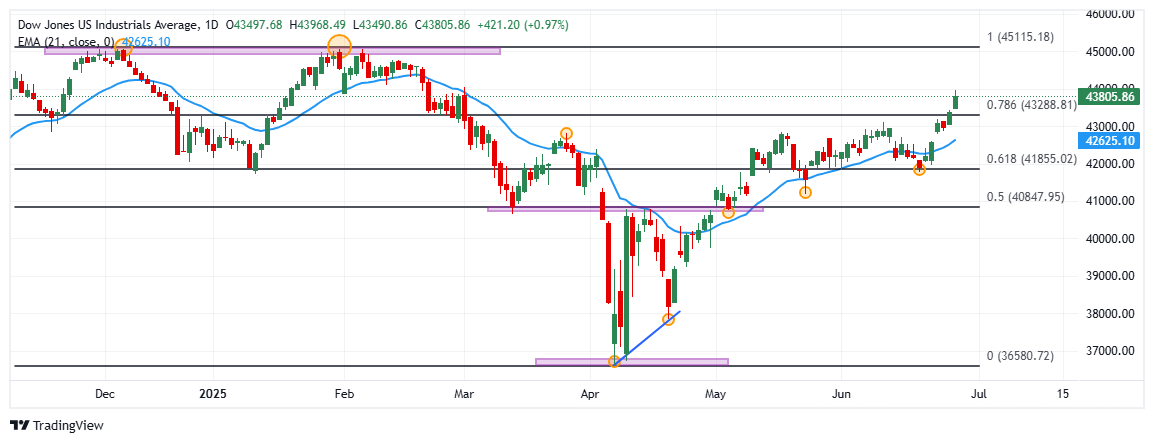- The Dow Jones rises 0.97% today, reaching maximums not seen since March 3 in 43,968.
- The Nasdaq 100 rebounds 0.35% daily, reaching new historical maximums at 22,602.
- The S&P 500 advances 0.47% in the day, registering new historical maximums in 6,185.
- The United States PCE increases a 2.7% year -on -year in May, exceeding market expectations.
The Dow Jones marked a daily minimum in 43,490, finding aggressive buyers who took the index to maximums not seen since March 3 in 43,968.
The Dow Jones industrial average opened in 43,497, while the Nasdaq 100 technological index began negotiations in 22,468. The S&P 500 began operating in 6,151, extending its profits in tune with the main stock market rates.
Nike and The Boeing Company drive Dow Jones to profit zone
The Dow Jones index wins 0.97% on the last day of the week, currently quoting at 43,805.
Nike (NKE) values shoot 15.19% daily, reaching maximum of March 12 at $ 74,19, signing its second consecutive session upwards.
In the same tune, The Boeing Company (BA) rises 5.91% in the day, visiting maximum of June 11 in $ 214.81, spinning two two consecutive days with profits.
The Dow Jones advances 421 points, reaching maximums of March 3 in 43,968.
The Nasdaq 100 records new historical maximums supported by ARM Holdings and Alphabet
The Nasdaq 100 technological index wins 0.35% in the day, marking a new historical maximum in 22,602.
The Arm Holdings (ARM) values advance 4.62% today, visiting maximums not seen since February 13 in $ 166.36, signing five consecutive days with profits.
In the same tune, Alphabet (Googl) shares rebound a 2.88% daily, visiting maximum of June 11 in $ 178.68, spinning four consecutive sessions upward.
The Nasdaq 100 goes up 78 points, operating the time of writing about 22,526, extending a streak of five consecutive days in positive terrain.
The S&P 500 concludes Friday by marking new historical maximums
According to the Office of Economic Analysis, the United States Personal Personal Consumption Price Index (PCE) increased by 2.7% year -on -year in May, exceeding the previous 2.6% and estimated.
In another front, the president of the Fed of Minneapolis, Neel Kashkari, mentioned in his speech that he expects two feats of fees in 2025, with a chance of making the first in September.
In this sense, the S&P 500 wins 29 points on Friday, reaching a new historical maximum in 6,185.
Technical Analysis of Dow Jones
The Dow Jones formed a short -term support given by the minimum of June 19 in 41,971. The following key support is located in 40,747, a pivot point of May 6, in convergence with the 50% fibonacci setback. Upwards, the important resistance is 45,068, maximum of January 31.
Dow Jones daily graphics

Dow Jones Faqs
The Dow Jones Industrial Avenge, one of the oldest stock market indexes in the world, consists of the 30 most negotiated values in the United States. The index is weighted by the price instead of capitalization. It is calculated by adding the prices of the values that compose it and dividing them by a factor, currently 0.152. The index was founded by Charles Dow, also founder of the Wall Street Journal. In recent years it has been criticized for not being sufficiently representative, since it only follows 30 companies, unlike broader rates such as S&P 500.
There are many factors that promote the Dow Jones Industrial Average (DJIA) index. The main one is the added performance of the companies that compose it, revealed in the quarterly reports of business benefits. The American and world macroeconomic data also contribute, since they influence investor confidence. The level of interest rates, set by the Federal Reserve (FED), also influences the DJia, since it affects the cost of credit, on which many companies depend largely. Therefore, inflation can be a determining factor, as well as other parameters that influence the decisions of the Federal Reserve.
Dow’s theory is a method to identify the main trend of the stock market developed by Charles Dow. A key step is to compare the direction of the Dow Jones Industrial Avenge (DJIA) and the Dow Jones Transportation Average (DJTA) and just follow the trends in which both move in the same direction. The volume is a confirmation criterion. The theory uses elements of maximum and minimum analysis. Dow’s theory raises three phases of the trend: accumulation, when intelligent money begins to buy or sell; Public participation, when the general public joins the trend; and distribution, when intelligent money abandons the trend.
There are several ways to operate with the DJ. One of them is to use ETF that allow investors to negotiate the DJ as a single value, instead of having to buy shares of the 30 companies that compose it. An outstanding example is the SPDR Dow Jones Industrial Avenge ETF (day). Future contracts on the DJ allow the specular operators about the future value of the index and the options provide the right, but not the obligation, to buy or sell the index at a predetermined price in the future. Investment funds allow investors to buy a part of a diversified portfolio of DJ values, which provides exposure to global index.
Source: Fx Street
I am Joshua Winder, a senior-level journalist and editor at World Stock Market. I specialize in covering news related to the stock market and economic trends. With more than 8 years of experience in this field, I have become an expert in financial reporting.







